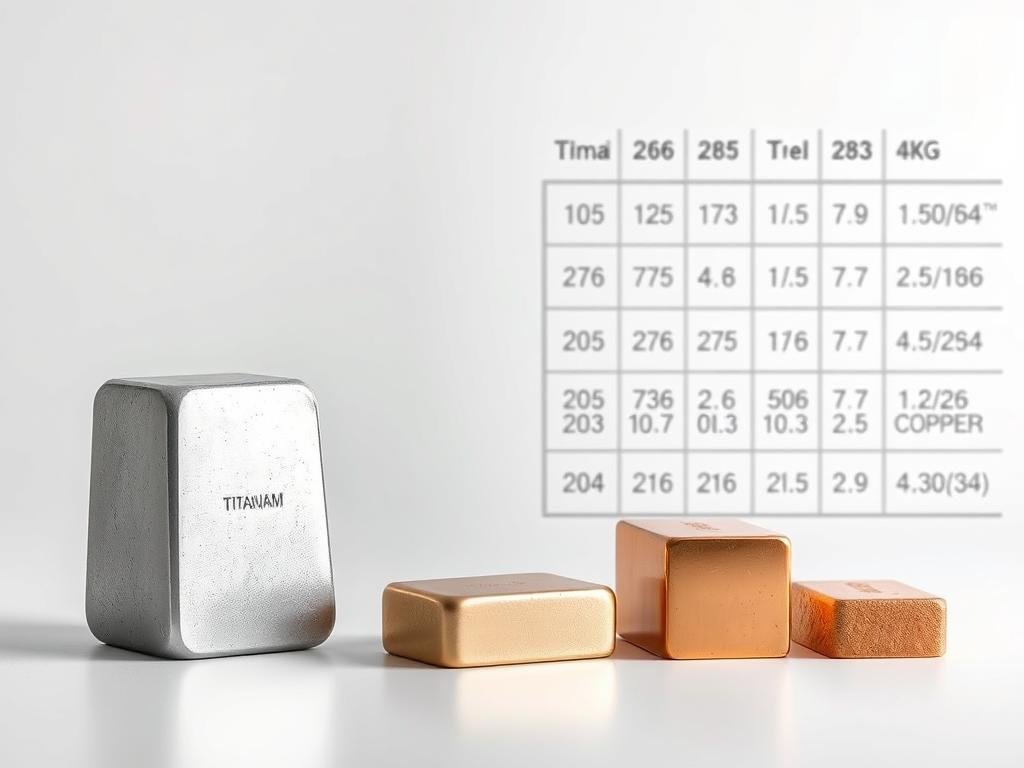Titanium is a remarkable metal known for its exceptional balance of low density and high strength. With a density of 4.51 g/cm³, it is approximately 57% that of steel, yet maintains superior strength characteristics.
This optimal strength-to-weight ratio makes titanium a premium material for weight-critical applications. As a transition metal, titanium’s unique physical and chemical properties contribute to its growing importance in modern engineering and manufacturing.
The density of titanium plays a crucial role in its selection for various high-performance applications across aerospace, medical, marine, and industrial sectors. This article will explore titanium’s density in relation to its other properties and compare it to alternative materials.
Understanding Titanium’s Physical Properties
Understanding the physical properties of titanium is essential for leveraging its potential in advanced engineering applications. Titanium’s unique characteristics make it a valuable material in industries ranging from aerospace to medical devices.
The Element Titanium: Basic Characteristics
Titanium is a transition metal with an atomic number of 22. It is known for its high strength, low density, and excellent corrosion resistance. Titanium’s inherent properties make it an ideal material for applications where weight and durability are critical.
Titanium Density: 4.51 g/cm³ Explained
The density of titanium is 4.51 g/cm³, which is significantly lower than many other metals used in industrial applications. This relatively low density, combined with its high strength, contributes to titanium’s excellent strength-to-weight ratio. The density of titanium is a critical factor in its selection for weight-sensitive applications.
Crystalline Structure and Its Impact on Density
Titanium exhibits two primary crystalline structures: the alpha phase, which has a hexagonal close-packed structure below 883°C, and the beta phase, with a body-centered cubic structure above 883°C. These different crystalline structures significantly affect titanium’s mechanical properties and density at various temperatures. Alloying elements can stabilize either phase, allowing for the creation of titanium alloys with customized properties for specific applications.
The transition between alpha and beta phases during processing can be manipulated to optimize titanium’s density-to-strength relationship. Moreover, the crystalline structure influences titanium’s ability to form a protective oxide layer, contributing to its excellent corrosion resistance despite its reactive nature.
Titanium Density Compared to Other Metals
The density of titanium relative to other metals plays a significant role in determining its suitability for different applications. This comparison is crucial in industries where both strength and weight are critical factors.
Titanium vs. Steel: Density Comparison
Titanium and steel are both widely used in industrial applications, but they have distinct density values. Titanium has a density of 4.51 g/cm³, whereas steel typically ranges between 7.8-8.0 g/cm³. This significant difference means that titanium is nearly half the weight of steel for the same volume, making it an attractive option for weight-sensitive applications. The specific strength of titanium alloy is 3.5 times that of stainless steel, which is a critical advantage in aerospace and other high-performance industries.

Titanium vs. Aluminum: Lightweight Alternatives
When comparing titanium to aluminum, another lightweight metal, titanium’s density (4.51 g/cm³) is higher than aluminum’s (2.7 g/cm³). However, titanium is three times stronger than aluminum, which compensates for its higher density in many applications. The choice between titanium and aluminum often depends on the specific requirements of the application, including factors like corrosion resistance and strength-to-weight ratio.
Density Comparison Chart of Common Industrial Metals
A comparison of the densities of common industrial metals reveals the unique position of titanium. The densities are as follows: titanium (4.51 g/cm³), steel (7.8-8.0 g/cm³), aluminum (2.7 g/cm³), copper (8.96 g/cm³), and magnesium (1.74 g/cm³). This data can be summarized in a simple density comparison chart:
| Metal | Density (g/cm³) |
|---|---|
| Titanium | 4.51 |
| Steel | 7.8-8.0 |
| Aluminum | 2.7 |
| Copper | 8.96 |
| Magnesium | 1.74 |
Titanium’s density positions it strategically between lightweight metals like aluminum and magnesium, and heavier structural metals like steel and copper. This balance, combined with its high specific strength and corrosion resistance, makes titanium an essential material in aerospace, medical implants, and other demanding applications.
The Strength-to-Weight Ratio Advantage
The outstanding mechanical properties of titanium, combined with its relatively low density, contribute to its high strength-to-weight ratio. This characteristic makes titanium an ideal material for applications where both strength and weight savings are critical.
How Titanium Achieves High Specific Strength
Titanium achieves its high specific strength through a combination of its inherent properties and alloying processes. The addition of elements such as aluminum and vanadium to titanium alloys enhances their mechanical properties. For instance, Ti-6Al-4V, a widely used titanium alloy, exhibits a tensile strength of 960 MPa and a yield strength of 892 MPa.
The difference between tensile and yield strength in Ti-6Al-4V is only 58 MPa, indicating a small margin between the onset of plastic deformation and ultimate failure. This characteristic is crucial for design considerations, as it influences the safety factors and material utilization in structural applications.
Mechanical Properties Related to Density
The mechanical properties of titanium, such as tensile and yield strength, are closely related to its density. With a density of 4.51 g/cm³, titanium offers a favorable balance between strength and weight. This balance is a key factor in the selection of titanium for demanding applications.
| Material | Density (g/cm³) | Tensile Strength (MPa) | Yield Strength (MPa) |
|---|---|---|---|
| Titanium (Ti-6Al-4V) | 4.51 | 960 | 892 |
| High-Strength Steel | 7.9 | 1200 | 1100 |
| Aluminum Alloy | 2.7 | 450 | 380 |
Tensile Strength and Yield Strength in Relation to Weight
When evaluating materials for structural applications, both tensile and yield strength are critical parameters. Tensile strength indicates the maximum stress a material can withstand, while yield strength marks the onset of plastic deformation. For titanium alloys like Ti-6Al-4V, these properties are particularly significant when considered in relation to their weight.

The strength-to-weight ratio of titanium alloys makes them particularly suitable for aerospace, automotive, and medical applications where minimizing weight while maintaining strength is essential.
Applications Leveraging Titanium’s Density
With its remarkable strength-to-weight ratio and resistance to corrosion, titanium is being increasingly utilized in demanding applications across multiple sectors. The material’s unique properties make it an ideal choice for industries where weight reduction and durability are paramount.
Aerospace Industry: Where Weight Matters Most
The aerospace industry is one of the primary beneficiaries of titanium’s advantageous density. By using titanium, aircraft manufacturers can significantly reduce the overall weight of their vehicles, leading to improved fuel efficiency and reduced emissions. “Titanium alloys are used extensively in aircraft structures, engines, and other components due to their high strength-to-weight ratio,” notes a leading aerospace engineer. The use of titanium in aerospace applications is a testament to its potential in weight-critical environments.
Medical Implants and Biocompatibility
Titanium’s biocompatibility and low density make it an excellent material for medical implants. The metal’s corrosion resistance ensures that it remains stable within the human body, reducing the risk of adverse reactions. Titanium implants, such as hip and knee replacements, benefit from the material’s strength and lightness, improving patient outcomes and quality of life. The non-magnetic nature of titanium is also advantageous in medical imaging applications.
Marine Applications: Corrosion Resistance and Density Benefits
Titanium’s exceptional corrosion resistance in seawater, coupled with its favorable strength-to-weight ratio, makes it highly valuable for marine applications. This is particularly true for components exposed to harsh marine environments.
Submarine Components
Titanium is used in submarine shells due to its non-magnetic properties, which prevent mine explosions. The material’s corrosion resistance also ensures the longevity of submarine components, even when exposed to seawater for extended periods.
Offshore Structures
In offshore oil and gas platforms, titanium’s corrosion resistance and strength-to-weight ratio are critical. The material is used in various components, including risers, heat exchangers, pumps, and valves. Titanium’s resistance to corrosion from seawater, hydrogen sulfide, carbon dioxide, and chlorides extends the service life of these components. Moreover, titanium’s lightweight nature reduces structural loads on offshore platforms and simplifies installation procedures. Emerging applications of titanium in offshore renewable energy structures, such as wind turbines and tidal generators, are also being explored due to the material’s corrosion resistance and fatigue strength.
Conclusion: The Future of Titanium in Weight-Critical Applications
With its optimal balance of density, strength, and corrosion resistance, titanium is poised to play a significant role in the future of weight-critical applications. The material‘s density of 4.51 g/cm³, combined with its high strength-to-weight ratio, makes it an ideal choice for industries where weight reduction is paramount.
Current trends in titanium production and processing technologies aim to reduce costs and expand applications, including advancements in powder metallurgy and additive manufacturing. Emerging applications for titanium, such as electric vehicles and renewable energy systems, are leveraging its density advantages. Ongoing research into new titanium alloys and processing techniques continues to push the boundaries of performance.
As a result, titanium’s unique properties will likely ensure its continued importance as a strategic material for high-performance applications. The future of titanium looks promising, with its attributes making it a prime candidate for next-generation aerospace platforms and other weight-critical applications.
